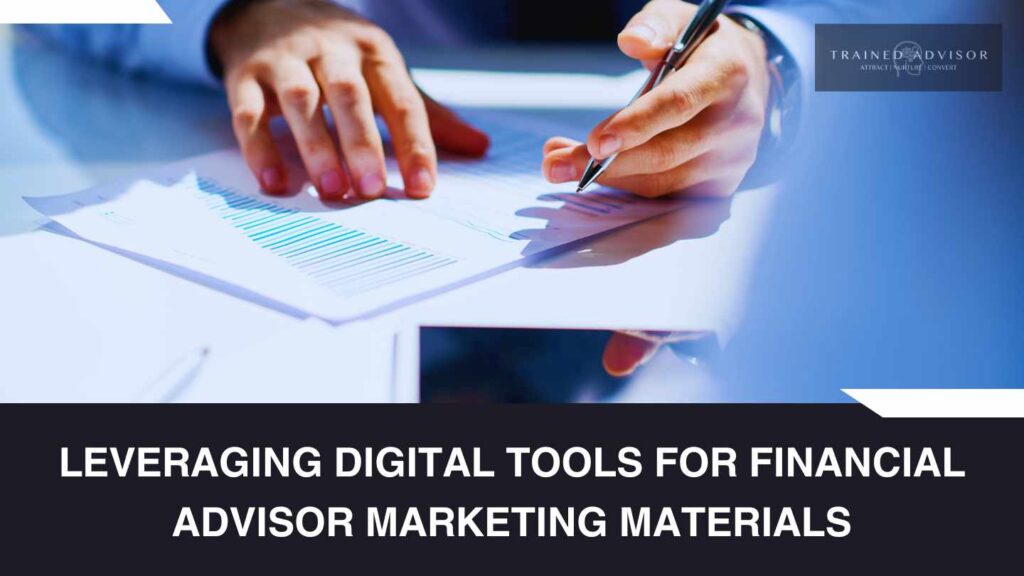Introduction
In the ever-competitive landscape of financial advising, standing out from the crowd is no longer just about offering top-notch services. It’s also about how effectively you market those services.
Financial advisor marketing materials play a pivotal role in this equation, acting as the bridge between your expertise and your potential clients. Whether you’re looking to attract new clients, build trust and credibility, or enhance your professional image, the right marketing materials can set you apart.
But why should you continue reading this article? Here are compelling reasons:
| Understand the importance | Learn why marketing materials are crucial in today’s financial advising landscape. |
| Craft effective materials | Discover the key components that make your marketing materials stand out. |
| Digital vs. Print | Navigate the benefits of both digital and print materials and learn how to integrate them for maximum impact. |
| Design tips | Even if you’re not a designer, gain essential insights into creating visually appealing materials. |
| Compliance guidance | Stay informed about the legal considerations and how to remain compliant with regulations. |
This guide aims to delve deep into the world of financial advisor marketing materials, providing you with actionable strategies, tips, and insights to elevate your marketing game.
From crafting compelling brochures to designing an engaging website, we’ve got you covered. So, let’s embark on this journey to transform your marketing materials into powerful tools for success.
Understanding Financial Advisor Marketing Materials
What Are Financial Advisor Marketing Materials?
Financial advisor marketing materials encompass a wide array of tools designed to communicate your services, values, and brand to potential and existing clients.
These materials range from brochures, business cards, and presentations to digital assets like websites, email newsletters, and social media profiles. Each piece plays a unique role in building your brand and facilitating client acquisition and retention.
Why Are Marketing Materials Crucial for Financial Advisors?
In the realm of financial advising, trust and credibility are your currency. Marketing materials serve as tangible representations of your brand, helping to:
- Build Trust: First impressions matter. Professionally designed materials signal reliability and expertise.
- Attract Clients: Effective materials speak directly to the needs and concerns of your target audience, drawing them closer to your services.
- Enhance Image: Consistent, high-quality materials reinforce your professional image, setting you apart from competitors.
What Financial Advisors Look for in Partnerships and Solutions
When marketing to financial advisors, it’s crucial to align your offerings with their needs and priorities:
- Ease of Integration: Solutions that seamlessly integrate with existing systems and processes are highly valued.
- Client Impact: Products and services that directly benefit their clients and improve client satisfaction are more likely to gain interest.
- Support and Training: Comprehensive support and training resources can differentiate your offering from competitors.
- Innovation and Insight: Advisors appreciate partners who provide innovative solutions and actionable insights that help them stay ahead.
Crafting Effective Financial Advisor Marketing Materials
Key Components of Successful Marketing Materials
Crafting marketing materials that resonate with your audience and reflect your professional image involves more than just listing services. Successful materials should include:
- Clear Messaging: Your value proposition should be front and center, explaining why clients should choose you over competitors.
- Professional Design: Aesthetics matter. A clean, professional design not only catches the eye but also reinforces your credibility.
- Contact Information: Make it easy for potential clients to reach out by prominently displaying your contact details.
Personalizing Your Materials for Your Target Audience
The one-size-fits-all approach doesn’t work in financial advising. Your materials should speak directly to your niche, whether they are business owners, high net worth individuals, or families looking for retirement planning. Personalization can involve:
- Identifying Pain Points: Address specific challenges your target audience faces and how you can solve them.
- Customized Solutions: Highlight services tailored to the needs of your audience, showing your understanding and expertise.
Incorporating Testimonials and Success Stories
Nothing builds trust like the endorsement of your existing clients. Including testimonials and success stories in your marketing materials can significantly enhance their effectiveness by:
- Providing Social Proof: Prospective clients are reassured by the positive experiences of others.
- Illustrating Your Impact: Success stories offer tangible examples of how you’ve helped clients achieve their financial goals.
Remember, while including testimonials, ensure you comply with any legal requirements and obtain permission from your clients.
Digital vs. Print Marketing Materials for Financial Advisors
The debate between digital and print materials is ongoing, but the truth is, both have a place in a comprehensive marketing strategy.
The Role of Digital Materials in Today’s Market
Digital materials offer unparalleled reach and convenience, making them essential for modern financial advisors. Key digital materials include:
Websites
Your online storefront, available 24/7 to provide information and capture leads.
Email Newsletters
A direct line to your clients, keeping them informed and engaged with your services.
Social Media Profiles
Platforms to build your brand, share insights, and connect with your audience.
Keeping Traditional Print Materials Relevant
Despite the digital age, print materials remain valuable for their tangibility and personal touch. Essential print materials include:
- Business Cards: A fundamental tool for networking, leaving a physical reminder of your encounter.
- Brochures and Flyers: Detailed information about your services that clients can take away from meetings or events.
- Direct Mail Campaigns: Personalized letters or postcards can make a significant impact in an increasingly digital world.
Integrating Digital and Print Materials for Maximum Impact
The most effective marketing strategies leverage the strengths of both digital and print materials. For instance, directing clients from a printed brochure to your website for more information, or using QR codes on business cards to link directly to your LinkedIn profile, creates a seamless experience that enhances engagement and brand recall.
Designing High-Impact Financial Advisor Marketing Materials
Working with Professional Designers vs. DIY Tools
When it comes to creating your marketing materials, you face a choice: hire a professional designer or go the DIY route with online tools. Both options have their merits.
- Professional Designers bring expertise and creativity to the table, ensuring your materials are not only visually appealing but also aligned with your brand identity. They can navigate complex design challenges and deliver polished results. However, this option might be more costly and require more time for collaboration.
- DIY Design Tools, such as Canva or Adobe Spark, offer templates and user-friendly interfaces that make it easy for non-designers to create decent materials. This route is more budget-friendly and offers quicker turnaround times but might lack the bespoke feel of professional design.

Essential Design Principles for Non-Designers
If you opt for the DIY approach or simply want to understand the design process better, here are some essential principles to keep in mind:
- Color Theory: Colors evoke emotions and convey messages. Choose a palette that reflects your brand’s personality and appeals to your target audience.
- Typography: The font you choose should be readable and align with your brand’s tone. Limit the number of different fonts to maintain a cohesive look.
- Layout and Composition: A well-organized layout guides the reader’s eye through the material. Use white space effectively to avoid clutter.

Measuring the Effectiveness of Your Marketing Materials
Setting Up Metrics for Success
To understand the impact of your marketing materials, establish clear metrics and goals. These might include:
- Lead Generation: The number of new leads generated from a specific piece of material.
- Engagement Rates: For digital materials, measure clicks, shares, and time spent on your website or social media pages.
- Conversion Rates: The percentage of leads that turn into clients as a result of your marketing efforts.
Utilizing Feedback to Refine Your Materials
Feedback is a goldmine for improvement. Gathering insights from your clients and prospects can help you refine your approach.
- Client Surveys: Ask for feedback directly through surveys or feedback forms.
- A/B Testing: Experiment with different versions of your materials to see which performs better in terms of engagement and conversion.
Conclusion
In the intricate landscape of financial advising, marketing materials stand as pivotal elements in distinguishing your services and engaging your target audience.
At Trained Advisor, we understand the profound impact well-crafted marketing materials can have on attracting and retaining clients.
By integrating the essential design principles, adhering to compliance and legal standards, leveraging feedback for continuous improvement, and staying ahead of emerging trends, Trained Advisor positions itself as a leader in empowering financial advisors.
Our journey doesn’t stop with creating effective marketing materials; it extends to continuously refining our strategies based on in-depth analytics, client feedback, and the evolving needs of the financial industry.
Trained Advisor is committed to providing our clients with the tools, knowledge, and support needed to navigate the competitive landscape of financial services successfully.





